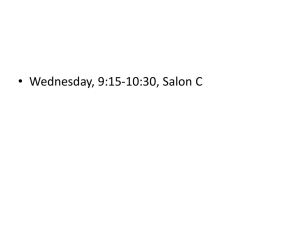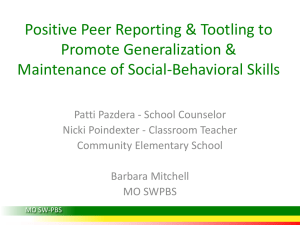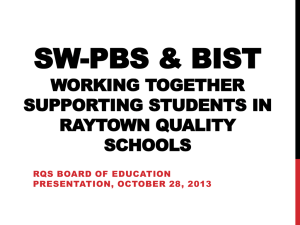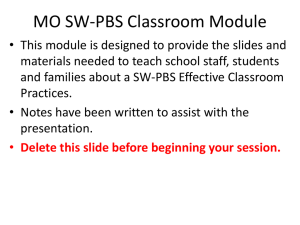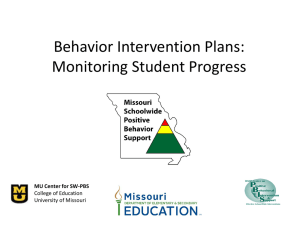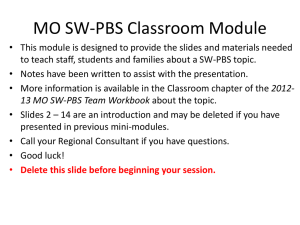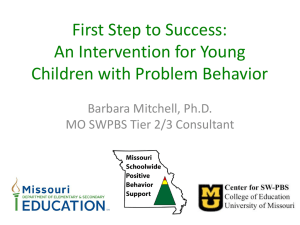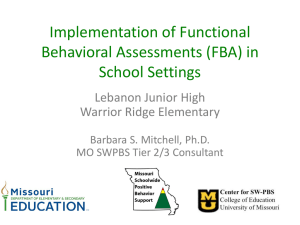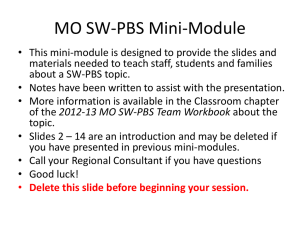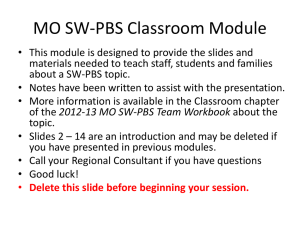3E_pptx - Missouri Schoolwide Positive Behavior Support
advertisement
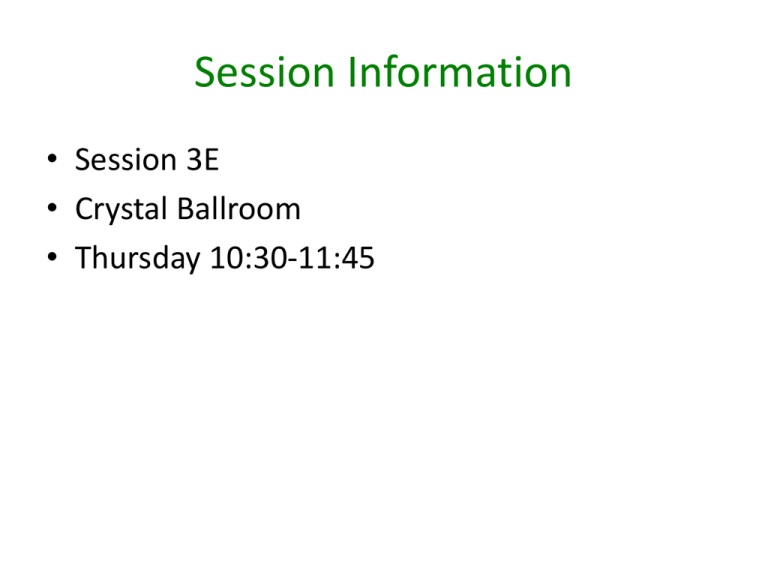
Session Information • Session 3E • Crystal Ballroom • Thursday 10:30-11:45 Using a School-wide Universal Screening Process to Identify Students At-Risk Julie Peterman- School Counselor Katie Curtis- Classroom Teacher Wyman Elementary, Rolla Public Schools Barbara Mitchell, Ph.D. MO SWPBS MO SW-PBS Session Outcomes • By the end of this session participants will be able to …. – Provide a rationale for using a school-wide screening process – Identify one or more instruments that can be used for screening – Describe a system for conducting school-wide screenings MO SW-PBS The Challenge • Mental, emotional, and behavioral health problems (MEB) affect 450 million worldwide (i.e., 1 out of 4) • Treatment and service for individuals experiencing mental health challenges is costly ($300 billion/year) • MEB challenges are associated with increased risk for negative outcomes including premature death. MO SW-PBS The Challenge • Approximately 14-20% of young people experience an MEB disorder at a given point in time (NRC & IOM, 2009, p. 15) • Close to 40% of young people have had at least one psychiatric diagnosis by the time they are 16 (Jaffee et al., 2005) MO SW-PBS The Challenge • Signs of potential MEB disorders are often evident at a very young age (Gilliam & Sharar, 2006) – One survey reported that half of all lifetime cases began by age 14 (Kessler et al., 2005) – U.S. sample data indicates median age at onset (Merikangas et al., 2010) • 6 years for anxiety disorders, • 11 for behavior disorders, • 13 for mood disorders, • 15 for substance use disorders MO SW-PBS The Challenge • Early onset of MEB disorders is predictive of lower school achievement as well as increased burden on the child welfare and juvenile justice systems (IOM, 2006) • Youth with MEB problems are at greater risk for later psychiatric and substance abuse problems (Gregory et al., 2007) MO SW-PBS The Challenge • Many MEB disorders rarely come to the attention of doctors or teachers (NRC & IOM, 2009, p. 37) – Fewer than 1 in 8 children with an MEB disorder is currently receiving treatment in the mental health or substance abuse systems – Only about 1 in 4 have ever received any treatment • Even if child meets criteria for DSM disorder this does NOT necessarily mean he/she receives special education services in school setting. MO SW-PBS The Good News! • Research has identified multiple factors that contribute to the development of MEB disorders. – Negative life events at family, school, peer and/or community level – Poverty – Family dysfunction and disruption – Child maltreatment – Community factors – School factors (NRC & IOM, 2009, p. 16) MO SW-PBS The Good News! • Interventions for successfully intervening are available. – National Registry of Evidence Based Programs & Practices (NREPP) http://www.nrepp.samhsa.gov/ – Institute of Education Sciences What Works Clearinghouse (WWC) http://ies.ed.gov/ncee/wwc/ – Evidence Based Intervention Network (EBI) http://ebi.missouri.edu/ (NRC & IOM, 2009, p. 16) MO SW-PBS The Good News! • There is great potential to reduce the number of new cases of MEB disorders and improve the lives of youth who experience these challenges. • We are limited only by inefficient and ineffective systems! (NRC & IOM, 2009, p. 16) MO SW-PBS Now is the Time “We won’t be able to stop every violent act, but if there is even one thing that we can do to prevent any of these events, then we have a deep obligation, all of us, to try.” - President Barack Obama • Top priorities = – make schools safer and increase access to mental health care providers & service MO SW-PBS Social Competence & Academic Achievement OUTCOMES Supporting Decision Making Supporting Staff Behavior PRACTICES Supporting Student Behavior SW Positive Behavior Support Three Levels of Implementation A Continuum of Support for All Academic Systems Behavioral Systems Tier Three Tier Three • Individual Students • Assessment-based • High Intensity • Individual Students • Assessment-based • Intense, durable procedures Tier Two • Some students (at-risk) • High efficiency • Rapid response Tier Two • Some students (at-risk) • High efficiency • Rapid response Tier One Tier One • All students • Preventive, proactive • All settings, all students • Preventive, proactive MO SW-PBS Purpose & Key Features of Tier 2 • Use data to identify students who are at risk for difficulties. • Provide standardized interventions that support student needs. • Use data used to monitor progress and make decisions. MO SW-PBS Identification Process • Teacher Nomination • Existing School Data • Universal Screening Instrument Allows for early intervention? (e.g., sooner, rather than later) Identifies externalizing & internalizing? MO SW-PBS Identification Process • Universal screening is recommended as an evidenced-based practice – President’s New Freedom Commission & Special Education Task Force – Surgeon General – Safe Schools/Healthy Students MO SW-PBS Identification Process • Advantages of systematic screening – Fast, efficient, and respectful – Include all children and youth of interest – If we make an error, the error tends to identify students who are not at-risk – Informs schools about the student population – Find groups of students with common needs – Facilitates resource mapping of services (University of Oregon Institute on Violence and Destructive Behavior) MO SW-PBS Identification Process • Screening not common because… – Behavior is often viewed as purposeful rather than environmental – Schools tend to be a reactive rather than proactive with respect to behavior – Impression that kids will “grow out of it” – Concern about profiling/stigmatizing – Fear of costs and potential to identify large number of EBD students MO SW-PBS Identification Process • Screening Not Common Because – Easier to screen vision & hearing because response falls in the realm of the parents – Political realities of managing parent reactions to behavior screenings; confidentiality – Systems skill set • Do we know how to respond to behavior with the same confidence that we respond to academic concerns? MO SW-PBS Resources Available • MO SWPBS Tier 2 Team Workbook May 2014, Chapter 3 (www.pbismissouri.org) – – – – Table of instruments Legal requirements and considerations Sample letter to parents Example protocols • • • • Social, Academic, & Emotional Behavior Risk Screener (SAEBRS) Strengths & Difficulties Questionnaire (SDQ) Behavioral & Emotional Screening System (BESS) Systematic Screening for Behavior Disorders (SSBD) MO SW-PBS Wyman Elementary Rolla Public Schools K-4 • 530 students • Early Childhood Special Education • SW-PBS School for 11 years MO SW-PBS A Little Peek into our SW-PBS System • Tier One Practices – Buzz Bucks – Wyman Classroom Rules Posters – Universal Behavior Screening • Tier 2/3 Team – B.E.E. Card (Check In, Check Out) – FBA • Team Collaboration – Student Intervention Team (SAT) – Response to Intervention (RtI) MO SW-PBS Our Universal Behavior Screening Journey • • • • • • Missing At-Risk Students Must Screen ALL Students Teacher Friendly Time Effective Cost Effective Useful Results MO SW-PBS Strengths & Difficulties Questionnaire • Pros – Descriptive Individual Student Reports – Free • Cons – Technical Difficulties – No Class Data MO SW-PBS Student Risk Screening Scale (Drummond-1994) • The SRSS is a 7-item screener used to identify students who are at risk for antisocial behavior • Uses a 4-point Likert Scale • • • • 0=Never 1=Occasionally 2=Sometimes 3=Frequently • Teachers evaluate each student on the following items • • • • • • • Steal Lie, cheat, sneak Behavior problems Peer rejection Low academic achievement Negative attitude Aggressive behavior • Student Risk is divided into 3 categories • Low MO SW-PBS =0–3 Moderate = 4 – 8 High = 9 - 21 Student Risk Screening Scale (SRSS) MO SW-PBS Reporting Results 2012 First Grade SRSS 100% 90% 80% 70% 60% High Moderate 50% Low 40% 30% 20% 10% 0% 1 MO SW-PBS 2 3 4 Total What About Internalizing Behaviors? Student Internalizing Behavior Screening Scale (Cook, 2008) • • The SIBSS is a 7-item screener used to identify students who are at risk for internalizing behavior Uses a 4-point Likert Scale • • • • • Teachers evaluate each student on the following items • • • • • • • • 0=Never 1=Occasionally 2=Sometimes 3=Frequently Nervous or Fearful Bullied by Peers Spends Time Alone Low Academic Achievement Withdrawn Seems Sad or Unhappy Complains About Being Sick or Hurt Student Risk is divided into 3 categories • Low MO SW-PBS =0–3 Moderate = 4 – 8 High = 9 - 21 Compromise • Needed to Combine Both Screenings (SRSS and SIBSS) • Wanted Teacher Friendly • Created Google Form • http://mbcurl.me/MV9Y MO SW-PBS SRSS School Wide Data MO SW-PBS SIBSS School Wide Data MO SW-PBS Individual Teacher Graphs Student Risk Screening Scale MO SW-PBS Student Internalizing Behavior Screening Scale Individual Teacher Results MO SW-PBS Individual Teacher Graphs Student Risk Screening Scale MO SW-PBS Student Internalizing Behavior Screening Scale Current Practice In Review • Early September – Presentation at Faculty Meeting – Share Link to Google Form • October – Share School Results with Staff – Distribute Teacher Results – Grade Level Sharing and Discussion • December and April – Share Link to Google Form – Share Results – Grade Level Sharing and Discussion • May – Review Process – Update as Needed MO SW-PBS We Have This Data, Now What? • • • • • Classroom Interventions Social Skills Groups Share with Student Assistance Team (SAT) Use in Special Education Evaluations Professional Development Opportunities MO SW-PBS RtI Connection MO SW-PBS Extra Resources • http://miblsi.cenmi.org/MiBLSiModel/Evaluation/Measures/S tudentRiskScreeningScale.aspx • http://rtinetwork.org/getstarted/checklists-and-forms • http://evaluation.ebrschools.org/eduWEB2/1000196/docs/sc ale_2__student_internalizing_beh_ss__-_sibss.pdf MO SW-PBS Session Outcomes • By the end of this session participants will be able to …. – Provide a rationale for using a school-wide screening process – Identify one or more instruments that can be used for screening – Describe a system for conducting school-wide screenings MO SW-PBS Contact Information • mitchellbs@missouri.edu • JPeterman@rolla.k12.mo.us • kcurtis@rolla.k12.mo.us

